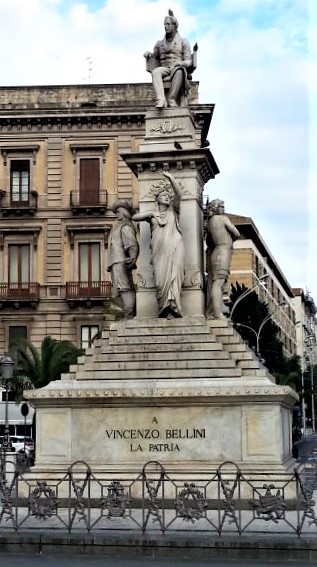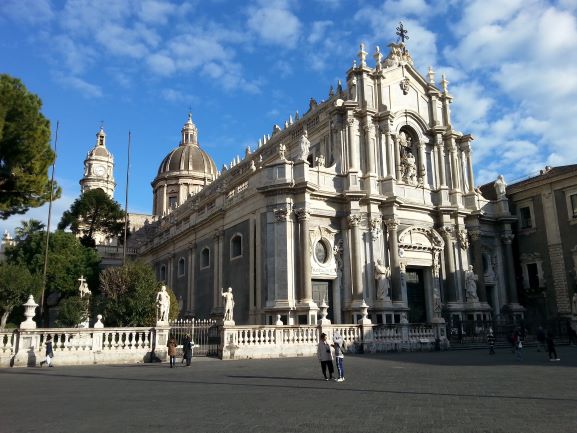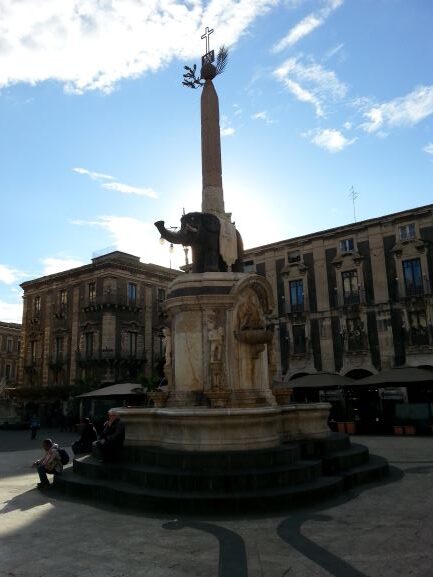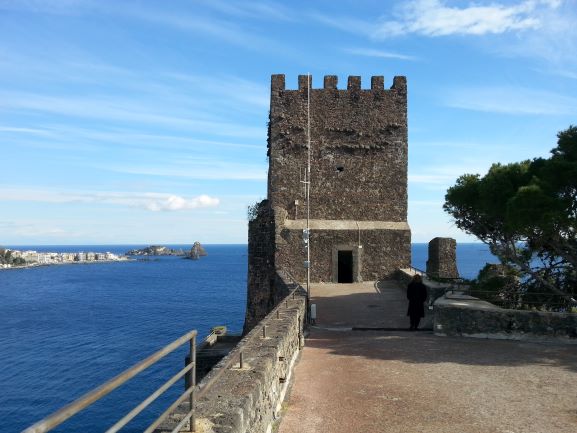Pasta alla Norma and Volcanoes
Catania, Sicily’s second city, has a student population to keep it lively, while the markets and gritty sections remind you that at its core Catania is chaotic and on edge because of the ever present threat of Mt. Etna.
A Short History
Catania’s history is one of the most interesting in all of Italy. Like much of southern Italy and eastern Sicily, Catania was part the Greek Empire; Magna Grecia. It was also conquered by the Romans, Muslim Arabs of the Byzantine Empire and the Normans, just like the rest of the region.
The big difference was that Catania was destroyed by lava and rock seventeen times in recorded history. Because of this, Catania was buried and had to be completely rebuilt time and time again. So, while the city was leveled numerous times by earthquakes, some ancient sites were preserved under layers of lava.
Archeological digs in Catania, like many places in Italy, are ongoing and have uncovered magnificent finds from both the Roman and Greek epochs.
In 1669 Mount Etna erupted and spewed lava. Records indicate the lava rock went as far as 100 miles. Some accounts indicate that the lava breached the walls of Catania, destroying much of the city and killing thousands. However, today, most historians believe that the city walls held and diverted the lava to the sea, saving the city and its inhabitants even though there are places in Catania that appear to contradict that theory.
Catania wasn’t so lucky in 1693 when an estimated 7.4 magnitude earthquake (Italy’s largest ever earthquake) centered just offshore leveled the city and killed an estimated two-thirds of the population. Rebuilding the city in the late baroque style of the era, Catania has one of the most beautiful and stunning old towns in Sicily, if not all of Italy.
Mt. Etna
The great Mount Etna looms large in Catania; both physically and psychologically. Just 18 miles away, you can see it clearly from much of Catania, so it is impossible to forget about its existence and its constant threat of destruction. I believe this leads to a certain sense of fatalism among Catanians. After all, an active volcano’s imminent eruption has to affect your world-view.
A trip to Mt. Etna is fairly easy to arrange. Tours depart daily and are easy to book. Private tours with a personal driver and guide are also available. Alternatively, there is a bus that can take you to the mountain at which point you hike up. Either way, bring warm clothes; even in the summer there is snow on the mountain and the winds whip.
On the day we went, we were delighted to be delayed in a nearby village when a farmer’s goats blocked the road as they moved from one field to another.
At Mount Etna, a cable car takes you to 2500 meters. You may be tempted to hike to the 2500 meter mark, but the cable car, while pricey, is a better choice. Once there, tour operators will try to get you into their 4x4s for a trip to 2900 meters. This is also pricey, but a fun way to get to close to the summit. You can also hike from 2500 to 2900 meters, a trip that takes about an hour.
Important note: Etna is an active volcano. Lava can be present and is extremely dangerous. In 2017 a BBC crew was injured by flying rocks and lava during an explosion. Be aware and keep safe.
The volcanic soil around Etna is excellent for growing grapes and other crops. Many tours are available that take you up the volcano and then tour wineries and farms that produce amazing local foodstuffs.
Thanks, Bellini
When I say Bellini, you probably think of the cocktail served at brunch made with Prosecco and peach nectar. That drink, however, was invented in Venice in the 20th century and named after Giovanni Bellini, a 15th century Venetian artist.
In Catania, the Bellini in question is Vincenzo Bellini, a 19th century composer. Bellini was born in Catania and as a child prodigy, supposedly sang arias at 18 months. His most famous works Il pirata, Capuleti, and I puritani are considered classics. Verdi, Wagner, Chopin, and Liszt were fans.

But, for me, Bellini’s greatest contribution to culture is Pasta alla Norma, named after his opera “Norma.” Pasta served over fried eggplant with tomato sauce topped with ricotta salata and basil. What could be better? The mellowness of the eggplant with the sweetness of tomatoes and salty sheep’s milk cheese. It must be heaven.
Pasta alla Norma is served all over Catania, nay Sicily, and there are as many variations, most of them tiny, as there are chefs. In fact, I’ll give a spin on my own version that I often make at home at the end of this post. But, to me, pasta alla Norma is the height of Sicilian cuisine. Simple, fresh, and made with local ingredients, anyone can make it, but few can make it well.
And, if you’d like to thank Vincenzo Bellini himself, there’s a statue of him in Catania at Piazza Stesicoro. There’s also a Bellini museum you can visit.
Saint Agatha
The Cathedral of Saint Agatha (Cattedrale di Sant’Agata) or simply the Catania Cathedral is right on the Piazza del Duomo in the heart of the old city and celebrates the martyred patron saint of Catania.

Agatha of Sicily was a fifteen year-old consecrated virgin who was imprisoned by Roman prefect Quintianus after she rebuffed his advances. She was raped and tortured in prison (some accounts say a brothel). When Quintianus saw that torture had no effect on Agatha, he ordered her breasts cut off. Legend has it that St. Peter came to her in a vision and healed her wounds. She was them rolled in hot coals with shards, but continued to proclaim her faith in Jesus at a time when Christians were persecuted by Romans. Some say she died from the burning of the coals, other records say she died later in prison.
Agatha’s feast day is February 5th and each year a festival to celebrate the saint is held in Catania from the 3rd to the 5th. Hundreds of thousands of Catanians, dressed in white sackcloths, black berets and white gloves, turn out for the procession of the relics of Agatha and treasures of the church. The events are punctuated with a fireworks display by the church.
And what would a feast day for a saint be without a special food to celebrate. For Saint Agatha it is the cassatelle di Sant’Agata, a sponge cake filled with chocolate and ricotta cheese (and sometimes candied fruit), topped with white icing and topped with a candied cherry. These little cakes represent Agatha’s severed breasts, a rather grotesque but delicious symbol.
The (mostly) traffic-free Piazza del Duomo is one of the main sights in Catania. Here you can visit the Cathedral of Saint Agatha and check out the magnificent baroque architecture of all the other buildings constructed after the 1693 earthquake.
In the middle of the piazza is the symbol of Catania, Fontana dell’Elefante. Nicknamed Liotru, no one knows when or how the elephant carved of black lava came to Catania. Liotru was moved several times before architect Giovanni Battista Vaccarini, who worked on the restoration of Saint Agatha Cathedral and designed the University Palace, took the elephant and placed an Egyptian-style obelisk on his back. He then placed the sculpture on a tall marble pedestal in a fountain. Liotru raises his trunk toward the cathedral.
Arancino
Little storefronts with display cases stuffed with prepared foods are very popular all over Italy and Catania is no exception. Some places (panificio and pasticceria) are like bakeries that wouldn’t seem out of the place in the US. Others, like a rosticceria, sell ready to go sandwiches, salads, and fried croquettes. Larger establishments may cook quick meals as well.

And in every food display case you’ll see the aranchino (called Arancina in Palermo). The arancino in Catania have a different shape than ones made in Palermo. They are cone shaped rather than round. Some say this is a tribute to the peak of Mt. Etna.
These tapered rice balls are traditionally filled with ragù, but today arancino can have seafood, sausage, or speck. Vegetarian arancino filled with mushrooms, peas, or eggplant and tomato sauce (a sort of pasta alla Norma arancino) are also popular.
After the pointed rice balls are filled, they are covered in bread crumbs and deep fried. Most arancino are sold at room temperature, but if you can find a place that is frying them, wait for a fresh batch to come out and you’ll be in for a real treat.
Arancino are usually taken to-go. So, grab a couple paper napkins and stroll up and down Via Etna for some window shopping or to Piazza Duomo for people watching while you munch your snack.
Outdoor Markets
One of the great joys in Sicily, in all of Italy, really, is shopping the outdoor markets. I hesitate to call them farmers markets because some of my favorite ones are so much more than that. In addition to the usual fruits, veggies, meat, and fish you’ll find household items like laundry detergent, tube socks, and handbags.
Behind Via Etnea in Piazza Carlo Alberto is the massive Catania outdoor market. Vendors are crammed together in the square with even more vendors snaking down the sidestreets leading from the piazza. The extraordinary amount of produce can be overwhelming. My suggestion is to take your time and explore each section at your own pace. Or, if you’re staying in Catania for a couple of days, come back.
If you’re staying in an apartment or hotel with a kitchenette, load up on fresh produce. Look for whatever is plentiful and stacked high. That’s what’s probably in season. Especially good are the blood oranges which make an incredible juice. The artichokes grown here are fantastic as well, but, in reality, you can’t go wrong as long as it’s fresh and local.
Even if you’re staying in a small hotel or B&B and can’t cook, the market still has a lot of things to offer. Load up on chocolate from Modica, it makes a great gift. Or look at the spices. If they’re sealed you can take them home with you. Same goes for sun dried tomatoes. Many vendors have them in vacuum sealed plastic. Once you try them, you’ll wonder how you ever lived without Sicilian sun dried tomatoes.
There are also vendors selling handbags, jewelry, shoes, luggage etc. Don’t expect to find designer labels here, it’s strictly cheap stuff, although we bought a bag here years ago and still use it today! You might also want to look for a Stromboli, a traditional woven basket that is the perfect size for shopping at the produce market. Word of caution: this market gets extremely busy. Expect to be elbow to elbow with other shoppers. You may be jostled or even pushed. If you don’t feel comfortable in crowds, this might not be the place for you. Also, keep your money and wallet hidden away. Pickpockets have been known to prowl the market.
The Catania fish market is considerably smaller, but even more raucous, if that is possible. Fish mongers shout and haggle with customers over the often still living catch of the day. Judging by the people gawking at the spectacle, a lot of people just come for the show.
Aci Castello
Speaking of taking a stroll, Aci Castello, a small town 9 kilometers north of Catania, is the ideal place to do so. There’s a lovely promenade along the Ionian Sea which is especially popular among couples.
You can also visit a Norman Castle which is now a museum and botanical garden. The museum and garden are nice, but very small. The real attraction is the view you get from the top of the castle, a panorama of the water and several volcanic islets. Bring your GoPro or your camera for an incredible addition to your Instachatbook feed.

The Cyclopean Isles were formed by volcanic eruptions half a million years ago. But, the legend of the islets is fantastic. Odysseus, of Homer’s Odyssey fame, was visiting Sicily and encountered the Cyclopes, a race of giants with a single eye in the middle of their forehead. One Cyclopes, Polyphemus, kills two of Odysseus’ men and captures Odysseus, holding him captive in a cave. Odysseus gets Polyphemus drunk, blinds him with a stick and escapes. Polyphemus, is a rage, hurls gigantic rocks into the void, attempting to sink Odysseus’ ship, but fails, as the rocks land in the water. Today, those rocks are the Cyclopean Isles. Now, isn’t that much more interesting than a simple geological event?
Recipe for Pasta alla Norma

There are dozens, if not hundreds of variations of pasta alla Norma. This recipe is my own and I make it all the time. It’s easy and quick. This recipe serves a lot of people, cut it in half if you like, but it’s also good the next day (just wait to add the cheese and basil).
I like Asian eggplant, the long kind. I know this is heresy to Italians, but Asian eggplant has far fewer seeds than the Italian varieties and is, therefore, less bitter. I like adding the eggplant to the tomato sauce because it melts into the sauce so nicely.
Ingredients:
1 pound penne pasta
1 ½ pounds Asian eggplant
¾ poind ricotta salata
1 28 ounce can of tomatoes (preferably fire-roasted)
1 small onion, diced
2 cloves garlic, thinly sliced
Red pepper flakes (optional)
3 tablespoons olive oil
Several sprigs of basil
Salt and pepper to taste
· Preheat oven to 375°
· Peel eggplant and cut lengthwise into ¼ planks. Lightly salt the eggplant and place in roasting pan coated with 1 tablespoon of olive oil. Roast for 20 minutes and check for doneness. The eggplant is cooked when fork tender.
· While the eggplant is in the oven, cook penne in salted water until al dente.
· Add 2 tablespoons of oil to a frying pan. Sauté onions and garlic with a pinch of salt until tender. Add tomatoes and red pepper flakes and cook for five minutes. You can leave the sauce chunky or puree mixture until fine.
· Remove cooked eggplant from the oven and chop into 1 inch cubes. Add to tomato sauce. Toss the penne with the sauce, grate cheese on top, add fresh basil and salt and pepper to taste.
Variations
1. Substitute ricotta cheese for ricotta salata. Fold the ricotta into the tomato sauce off the heat. You may want to add more salt to make up for the missing ricotta salata.
2. Fry the eggplant instead of roasting it. I like covering the eggplant in rice flour or potato starch before frying in olive oil. Make sure the eggplant is cooked all the way through or it will be tough. Serve the eggplant under that pasta instead of in the sauce.
3. Though far from traditional, you can also bread the eggplant and fry it. Dunk eggplant planks in flour, then milk, then breadcrumbs. Fry in olive oil. Do not add to tomato sauce as the crust will get soggy. Instead, serve on top of the sauce.
4. If you prefer, substitute Parmesan cheese for ricotta salata, or, better yet, Pecorino Romano.
5. Sardines of anchovies are often chopped and added to tomato sauces in Sicily. If you cannot find fresh ones, omit them, the canned ones are no substitute.
Transportation
Catania-Fontanarossa Airport
Direct flights from many European cities, the UK, Russia, Egypt, the Middle East and Turkey.
Ground Transportation
There is a bus from the airport to Catania
Catania is also a hub for rail and bus service to the rest of Italy.
Local transportation
City bus service connects the entire city. Tickets available at tobacco shops.
Uber does not operate in Catania, but taxis are widely available. Rental car may be desirable if you are making daytrips around Sicily.
Mount Etna
Private tours are easily booked online or through your hotel. There is a train and bus that offers transport. You can also go to a tabacchi (tobacco) shop and buy a ticket there.
Index of Food & Drink in Catania
Fud Bottega Sicula
Simultaneously contemporary and rustic. Famous for their burgers, they also make their own potato chips. Vegetarian options available.
Via Santa Filomena, 35, 95129 Catania CT, Italy
Savia
Great spot for Sicilian pastry or Arancino right on Via Etnea.
302/304, Via Etnea, 95100 Catania CT, Italy
Prestipino Café
Great spot on Piazza del Duomo for espresso, pastries, snacks, or a beer.
Piazza Duomo 1, 95124 Catania, Sicily, Italy
A putia dell’Ostello
Cool restaurant and bar with a river running through it.
Piazza Curro’ 6 | Downtown, 95121 Catania, Sicily, Italy
Index of Things to Do in Catania
Teatro Massimo Bellini
Opera house in Catania named after Vincenzo Bellini. They put on a full slate of performances every year.
Via Giuseppe Perrotta, 12, 95131 Catania CT, Italy
Bellini Museum
Composer Vincenzo Bellini’s birthplace has relics, personal items, and furniture arranged in chronological order.
Piazza S. Francesco d’Assisi, 3, 95124 Catania CT, Italy
Piazza del Duomo
Great spot to hang out and people watch. Lots of tourists, yes, but college students can make this square interesting. We once spent an hour watching a peaceful student protest unfold.
95100 Catania, Metropolitan city of Catania, Italy
Fontana dell’Elefante
Liotru the elephant, carved of black lava and the symbol of Catania, sits high above street level playfully raises his trunk towards the cathedral.
Located in the center of the Piazza del Duomo.
Piazza del Duomo, 95124 Catania CT, Italy
Roman Theater
Second century BC Roman amphitheater.
Aci Castello
Gorgeous promenade leads to a Norman castle with spectacular views
Piazza Castello, 95021, Aci Castello, Sicily, Italy
Index of Shopping in Catania
Piazza Carlo Alberto outdoor market
Lively and crowded market bursting with fresh produce and household goods.
Piazza Carlo Alberto, Catania, Sicily
Pescheria outdoor market
Raucous fish market held mornings just outside the Duomo. Open most weekday mornings. Best to get there early.
Just outside the piazza del Duomo. Look for the Fontana dell’Amenano.
Mizzica
Handmade Sicilian jewelry
Via Giuseppe Garibaldi 13 | vicino piazza Duomo, 95121 Catania, Sicily, Italy
Porta Uzeda
Shop here for relatively inexpensive souvenirs including marionettes.
Porta Uzeda near the Piazza del Duomo
Index of Places to Stay in Catania
Una Hotel Palace
Nice location right on Via Etnea with a rooftop bar.
Via Etnea, 218, 95131 Catania CT, Italy
Romano House
Boutique hotel close to the center of the city.
Via Giovanni di Prima, 20, 95131 Catania CT, Italy
BAD – Bed and Breakfast and Design
Quirky, budget-friendly B&B near the Piazza del Duomo
Via Cristoforo Colombo, 24, 95121 Catania CT, Italy
About the Author

Brent Petersen is the Editor-in-Chief of Destination Eat Drink. He currently resides in Setubal, Portugal. Brent has written the novel “Truffle Hunt” (Eckhartz Press) and the short story collection “That Bird.” He’s also written several Foodie Travel Guides to cities in Italy including Rome, Naples, Palermo, the Amalfi Coast, the Cinque Terre, and Turin. Brent’s podcast, also called Destination Eat Drink, is available on all major podcasting platforms and is distributed by the Radio Misfits Podcast Network.
